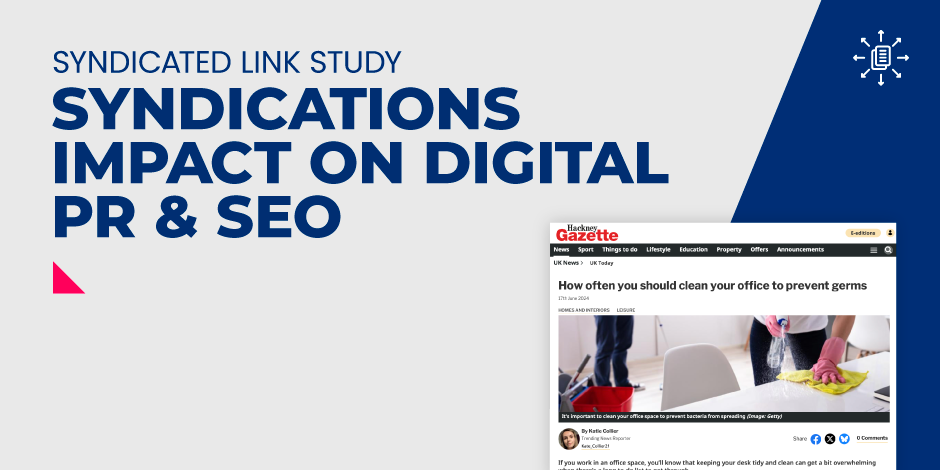
Syndicated Link Study - Syndications Impact On Digital PR & SEO
As a digital PR agency, we are no strangers to syndicated links. In fact, we’ve earned thousands of them to our clients' websites in recent years.
In this time, we have had countless conversations with both existing and potential new clients about the value offered by syndicated backlinks when it comes to their impact on SEO visibility. These discussions show that opinions surrounding syndicated links vary significantly, with some clients asking that we specifically target syndicated networks of high authority and far reaching publications while others request such networks be avoided completely.
Regardless, throughout the industry, discussions surrounding the SEO impact of backlinks coming from a syndicated network of authority websites tend to be based on anecdotes and intuition, as opposed to hard data.
The challenge in finding robust data to draw a correlation between authority syndicated digital PR links and SEO visibility lies in the fact that genuinely powerful syndicated links are hard to control as a variable. When they are earned, they tend to be earned alongside countless other non-syndicated links which means that isolating the syndicated links as the main driver of any increased SEO visibility is near impossible.
As luck would have it, not long ago we did manage to run an almost completely controlled syndicated backlink study, purely by chance. This article explains our (coincidental) methodology, the results seen, and the implications that this has on the impact of syndicated links within the digital PR industry more generally.
TL;DR
If you’re short on time and want the key takeaways, I’d refer you to our CEO’s LinkedIn post below. Otherwise, you will find the full details of this study throughout the rest of this article.
What is syndication?
Before we get into detail on what happened, how this study came to be, and the key findings of it, we should first start by defining what syndication even is.
Definition (general and digital PR specific)
Syndication typically means republishing a piece of content (whether that be an article, infographic or a video) on more than one website, so that there is greater reach and coverage potential for that piece of content.
While, within the SEO and digital PR industry, there are a few different technical definitions of what makes a network of websites connected via syndication, generally a collection of sites will be considered to be part of a syndication network when they meet all (or at least some) of the below criteria:
- Multiple websites/publications hosted on the same server/IP address.
- Multiple websites/publications owned and operated by a single company/entity/organization, with this confirmed/highlighted across the network sites.
- The exact same articles/content being republished across multiple connected websites/websites.
- The same author publishing the same articles across multiple connected websites/publications.
It’s important to note that, although they both might seem similar, content syndication is not the same as guest posting/blogging. A guest post is a new/unique piece of content which is written for a single publication or website, whereas syndicated content is simply taking the same piece of content and republishing it on other connected publications.
The different types of syndication
Given digital PR’s focus on earning top-tier links and coverage, the websites making up a syndicated network that will be reported on within a digital PR scope of work tend to have high domain authority and strong SEO visibility. As a result, for the purposes of digital PR, some types of syndication may never be reported on or even ignored entirely.
Below, we will run through the two main types of syndication, and highlight which one is most often found and reported on in the digital PR space.
Paid and self-submission press release syndication
This involves submitting (and usually paying for) your press releases to be shared across multiple online platforms, news outlets, and media databases.
Self-submission press release syndication platforms, like PR Newswire, Business Wire, and GlobeNewswire, allow you to send your press releases to thousands of journalists, and get them published on many different news sites and news aggregators, all at once.
While this type of syndication can result in things like immediate exposure to a wide audience, increased chances of media pickup, and quick promotion of time-sensitive announcements (such as product launches or major updates), the self-submission aspect of it means that it isn’t a type found in the reports provided by the best digital PR agencies.
Organic press release/earned syndication
Similar to the type of syndication mentioned above, only notably different in that this kind of coverage is earned rather than purchased or self-published.
This is the type of syndication most often found in digital PR reports, and is what this case study relates to.
When digital PR teams are sending their press releases to journalists who write for top-tier websites and publications, sometimes those journalists will write for a syndicated network of exclusive publications (this is to say that only employed journalists can publish on them). When this happens and the story is picked up, the journalist will often publish their article across all of the websites within the syndicated network that they’re a part of.
The key things to remember with this type of syndication is that:
- The links/coverage placed across the network will be genuinely earned, meaning that coverage can’t be easily replicated by competitors via paid syndication or self-submission sites.
- All of the websites found within the syndicated network will be high authority with a good amount of organic visibility.
Notable mentions
While the above two types of syndication are the main types found across the SEO and digital PR industries, there are a couple of other types which can be a blend of the two which are worth noting:
- Social Media Syndication - Sharing syndicated content across social media platforms to amplify reach.
- RSS Feed Syndication - Distributing content automatically through RSS (Really Simple Syndication) feeds which audiences may also subscribe to.
Now that we’ve defined what we mean when we refer to syndication, and discussed the type that is most commonly found within the digital PR industry, we can move on to the actual case study.
The study
To design an effective SEO experiment, and to test the impact of syndicated digital PR links on SEO visibility, we would require a few key things:
- A test environment - In this case this would consist of two things:
- A test website - Where we could point our syndicated links to.
- A controlled testing environment - Where no (or very limited) other variables will be introduced throughout the testing period which could influence the SEO rankings/visibility of our test website.
- An independent variable - The variable which will change, for this study this would be the ability to earn a burst of syndicated digital PR backlinks to our test website.
- A dependent variable - The variable which we will observe and measure, here this would be the rankings/SEO visibility of our test website, and we could use SEO tools to track and observe this (i.e. a rank tracker and SEO visibility tool like ahrefs, and ideally also Google Search Console and Google Analytics 4 setup for our test website).
- A control variable - The variable which doesn’t change, in this case this is the fact that other potential factors that could (or would) influence the rankings/SEO visibility of our test website were kept to a minimum throughout the testing period.
As luck would have it, all of the above requirements fell into place by coincidence when we started tackling a new client project.
When we first began working on it, the test website (OfficeClearanceLondon.net) hosted a basic website which had been live and indexed for a number of years.
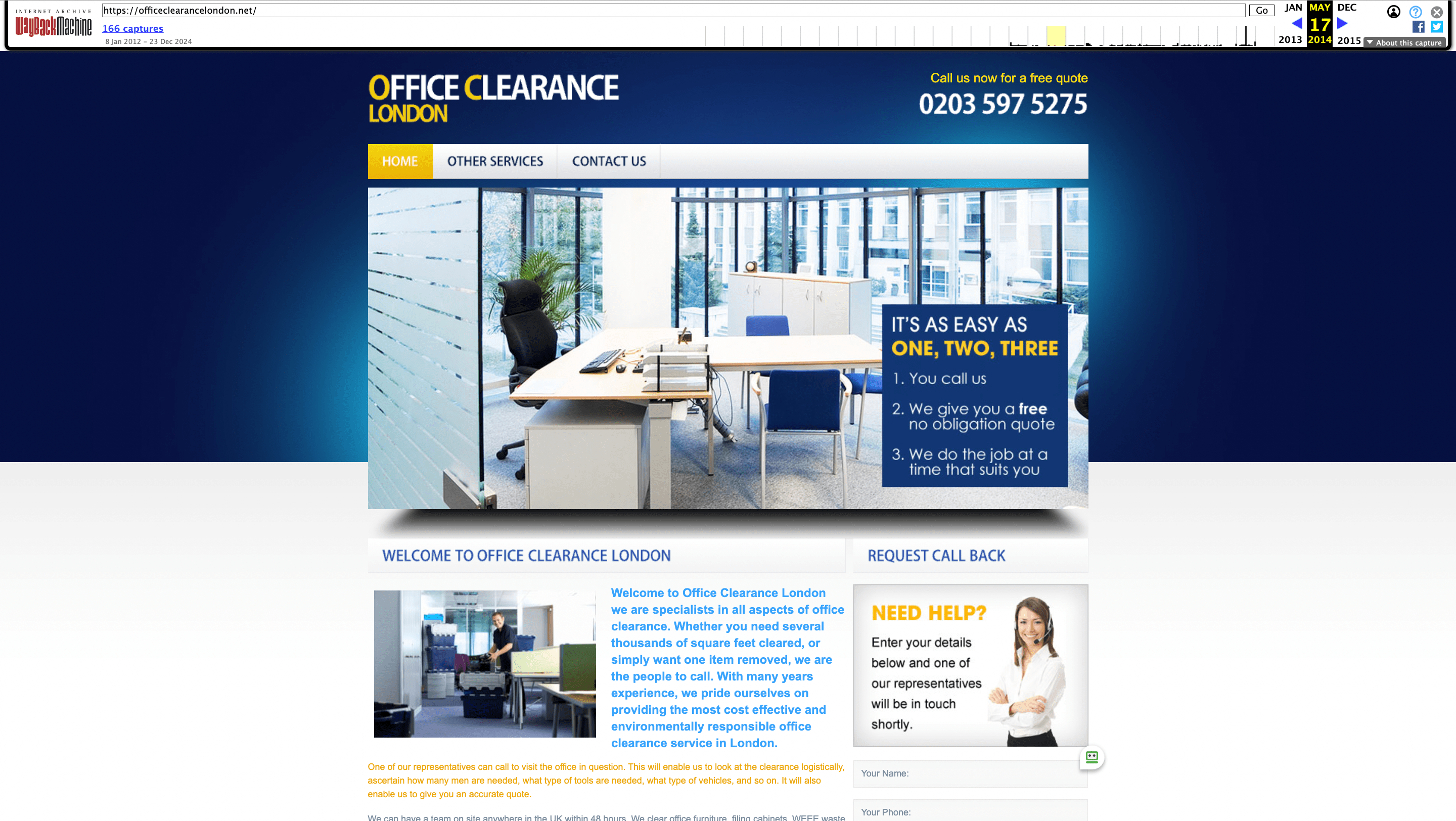
Screenshot from archive.org showing the test website back in 2014, with the same content and design as it has now.
The test website never ranked on page 1 (or even in the first few pages) of Google for any of its target keywords.
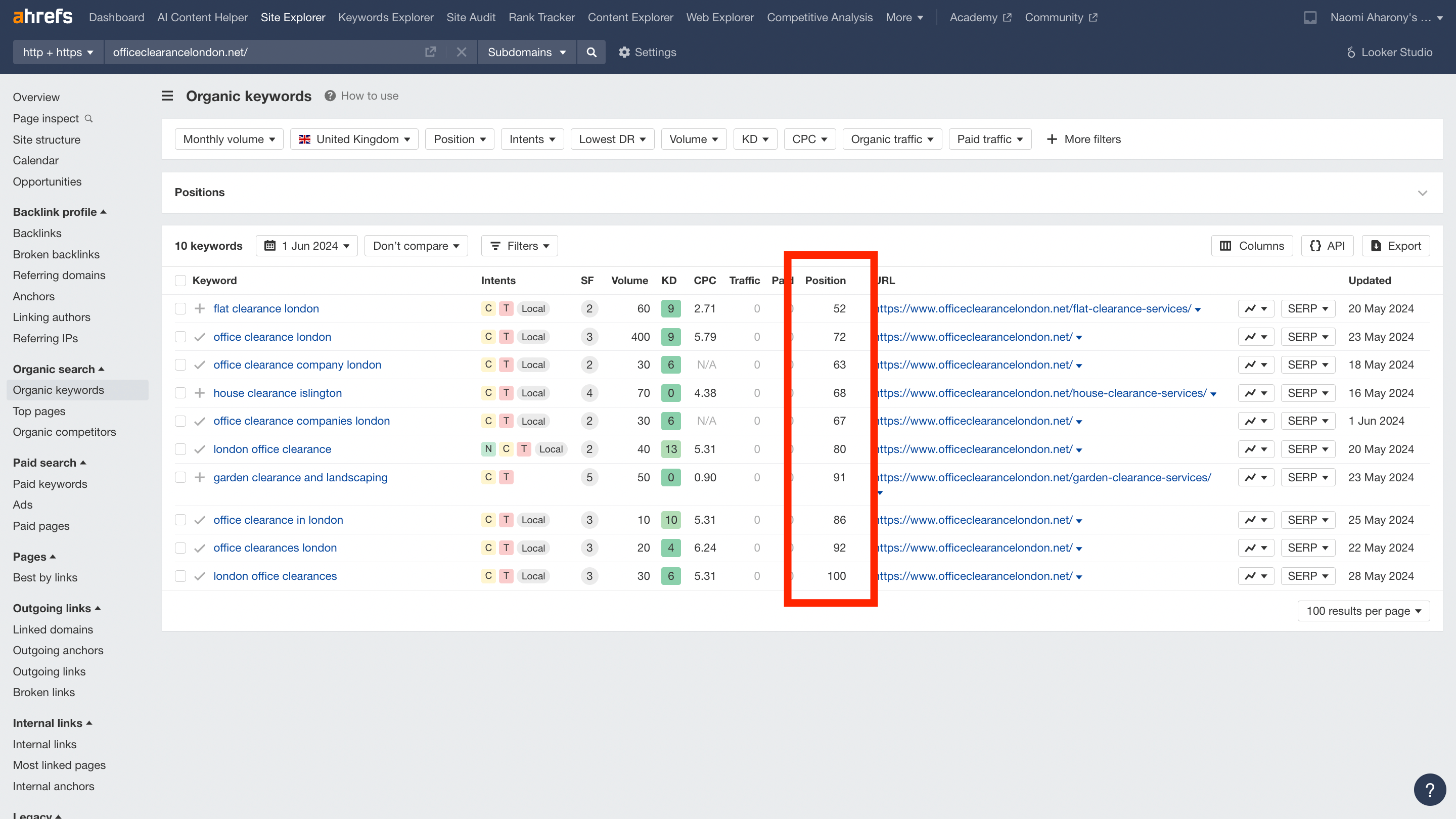
Screenshot from ahrefs showing that the test website had no real SEO visibility back in June 2024 when we first started working on it.
The test website’s SEO rankings (or lack thereof) were stable, and no new authority backlinks had been built/earned to the site within the last few years (although they had picked up some of your standard scraper-style links).
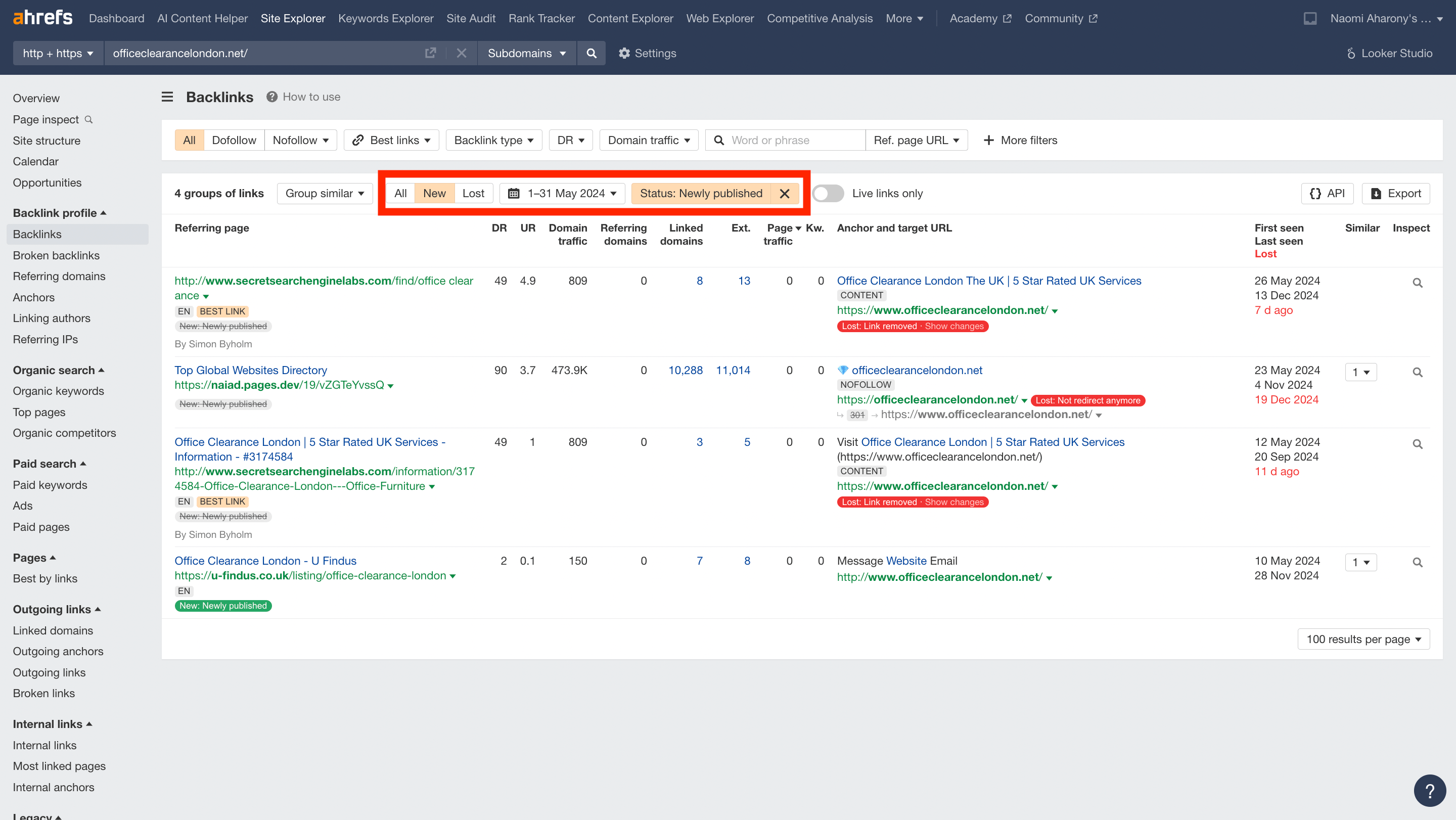
Screenshot from ahrefs showing that no new backlinks were found to be linking to the test website within a year of us starting work on it.
Also, no major technical or on-site changes had been made on the test website recently.
The website's limited backlink profile and SEO visibility, alongside the fact that no SEO improvements had been made in recent months, meant that it was not only the perfect situation for a controlled experiment (even if we didn’t realise it at the time), but that it was also a great candidate to benefit from digital PR.
So, in May 2024, we agreed that we’d start working on the site to improve its SEO visibility with the ultimate aim of getting it to rank top for its target keywords.
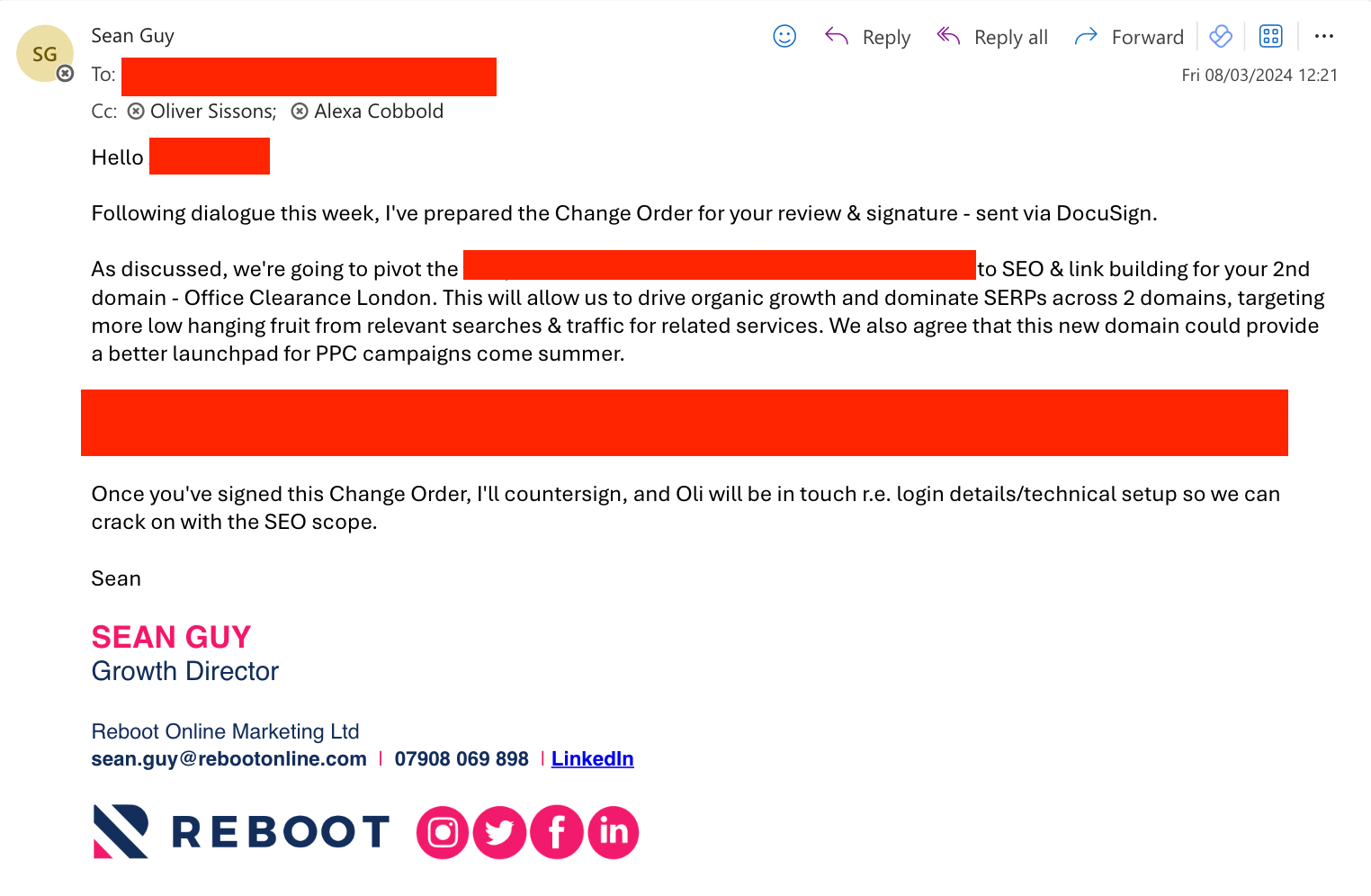
A screenshot showing us confirming to the client that we will start SEO work on the test website, sensitive details have been redacted.
To kick things off, we focused on earning new high authority links via data-driven digital PR.
Our general hypothesis was that in earning a good volume of new backlinks from high authority websites (via digital PR), we would improve the website's overall authority and, as a result, its positioning in the organic search results.
Within a couple of weeks of starting work on the test website (or rather off the site, since we were running digital PR campaigns at this time) our team earned an initial burst of over 180 syndicated digital PR links.
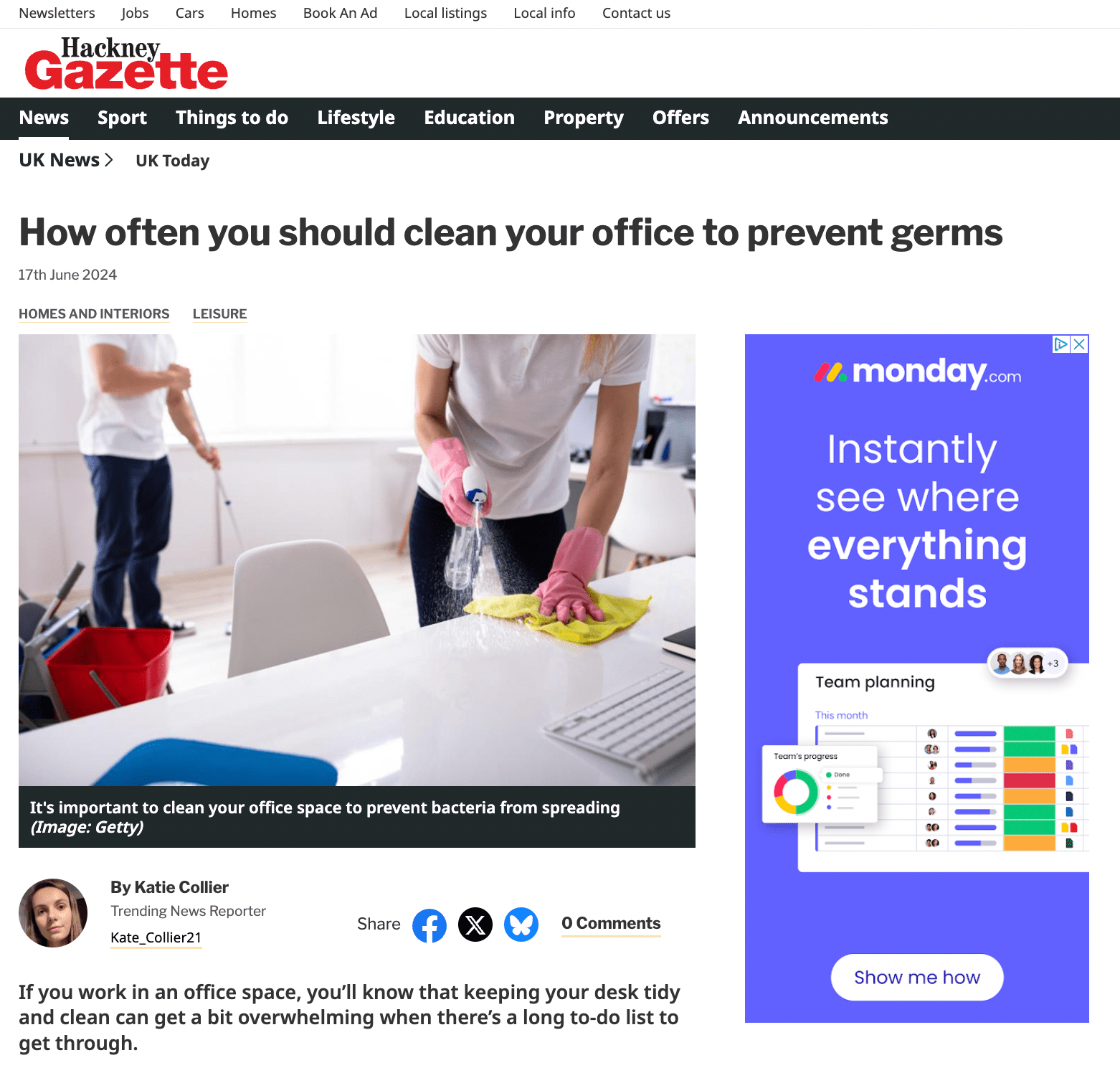
Example of the syndicated coverage that our initial digital PR campaign generated.
The average Ahrefs Domain Rating (DR) of the syndicated links was DR70.

Screenshot of the ahrefs Domain Rating (DR) tool showing the DR one of the linking syndicated websites.
Our initial campaign earned links from the Newsquest syndication network, which resulted in backlinks from sites like:
- Kilburn Times
- Harrow Times
- Dumbarton Reporter
- Hackney Gazette
- Islington Gazette
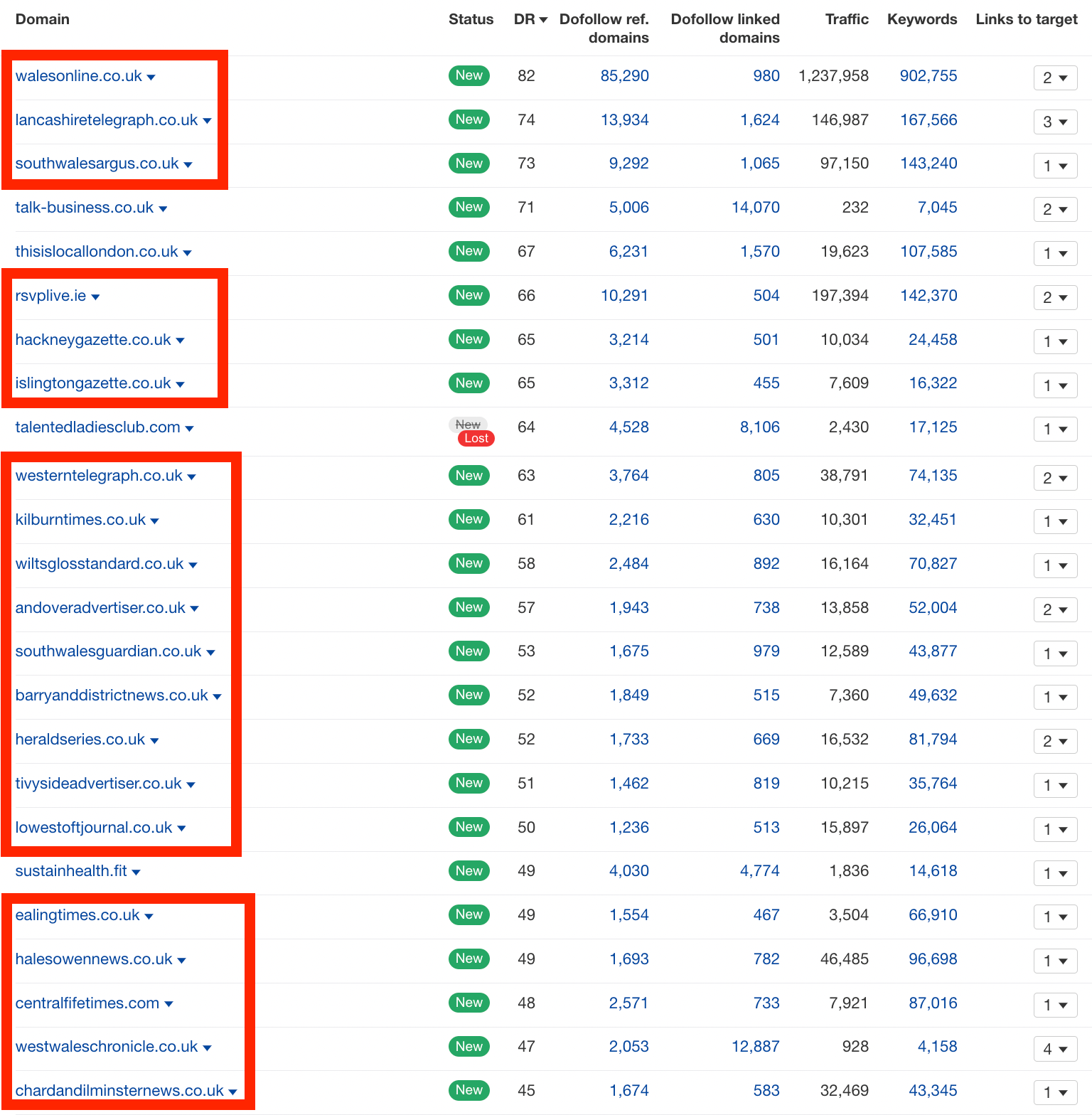
Screenshot of the syndicated coverage earned from the ahrefs Referring Domains report.
As is common with syndicated coverage, the linking articles were virtually identical across the network.
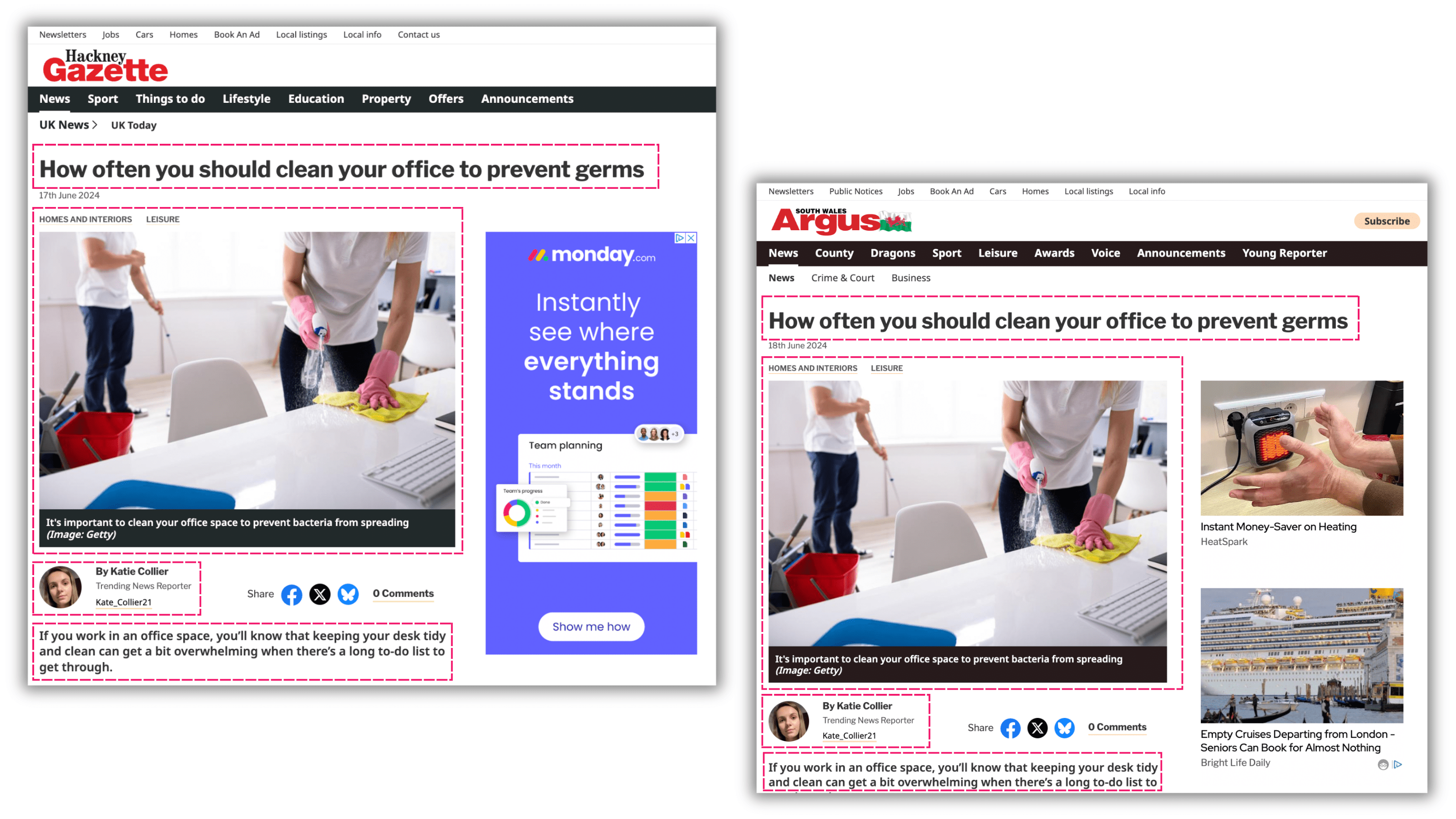
Screenshots comparing two pieces of syndicated coverage.
Within weeks of our syndicated links going live, and at a time when (due to the clients budget) we were only at the initial SEO auditing, on-site planning and content writing stage, we saw staggering increases in SEO visibility over 4 distinct bursts.
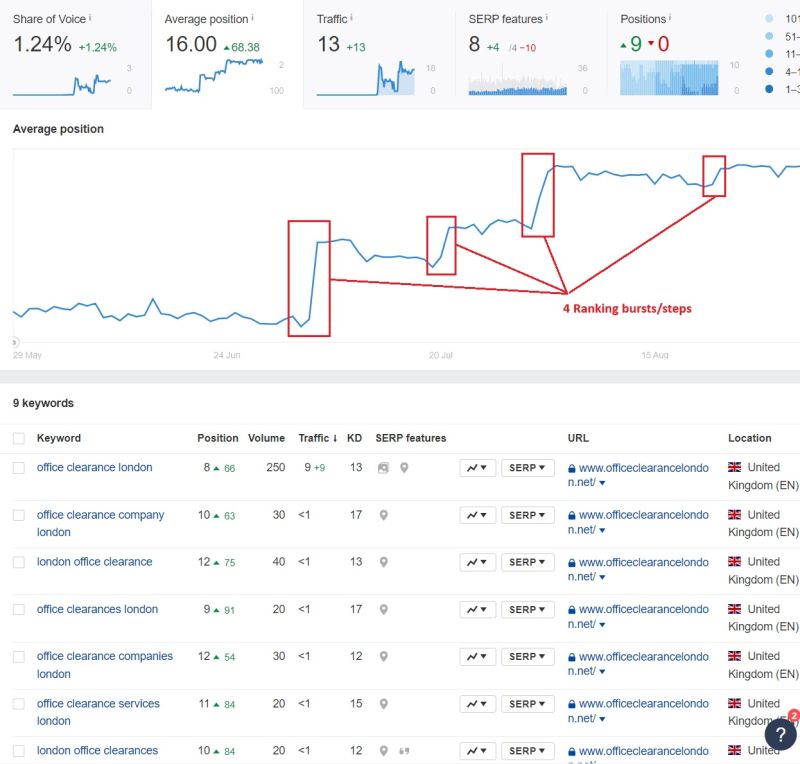
Screenshot from ahrefs showing the SEO visibility increase seen for the test website in the weeks following the syndicated links going live, notably 4 distinct bursts of growth.
Despite having no on-site changes made within the timeframe observed and only receiving that initial burst of syndicated links, the test website went from not ranking anywhere near the first page for its target keywords to page 1 across all of them:
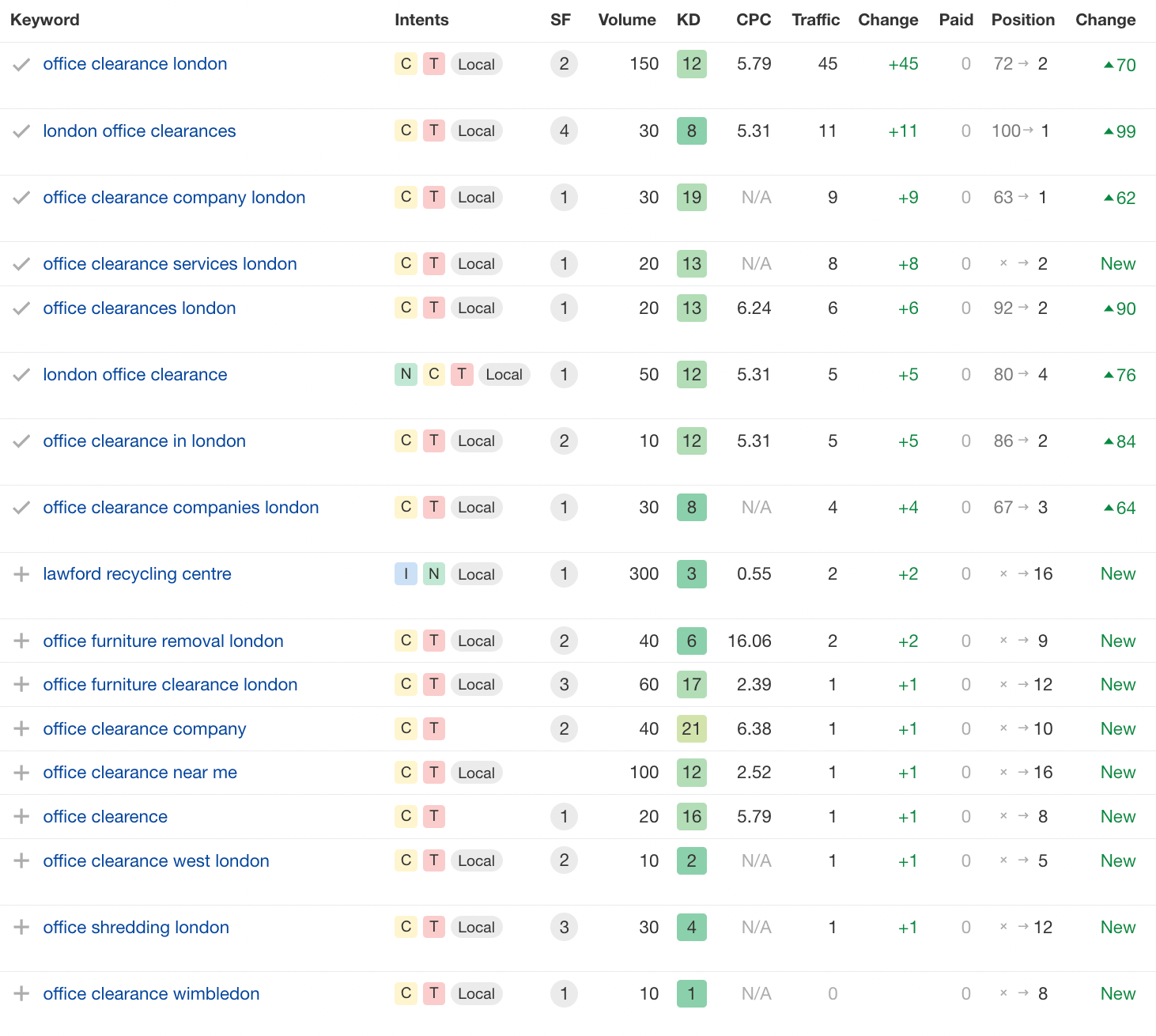
Screenshot from ahrefs showing the increase in organic rankings experienced by the test website.
Take aways
This case study highlights the impact that (the right kind of) syndicated backlinks can have on a website's SEO visibility.
In this SEO experiment/case study, we were fortunate enough to hit the syndication jackpot, which turned out to be exactly the right tactic for this domain.
In order to drastically improve its keyword rankings, the test website needed to earn a good volume of high authority links. We just so happened to earn only syndicated links over the test period, which clearly resulted in some impressive gains for the site.
How we think about syndication
To paraphrase our CEO Shai’s words:
“Some think that Syndicated links help while others discount them all believing Google treats them as just one link, this test proves that the former is true.”
If you’re interested in earning high authority syndicated backlinks to your site, and/or driving similar SEO increases for your brand, get in touch.
